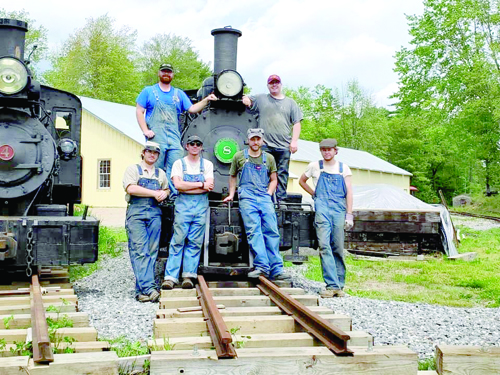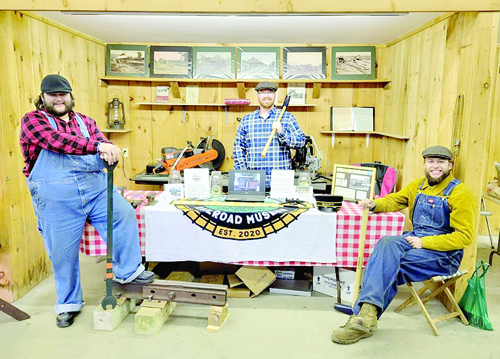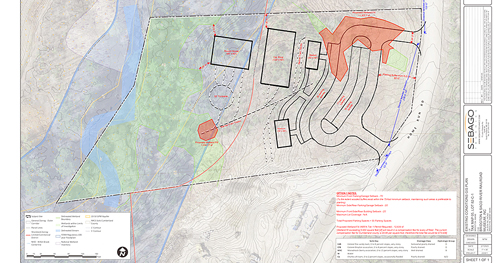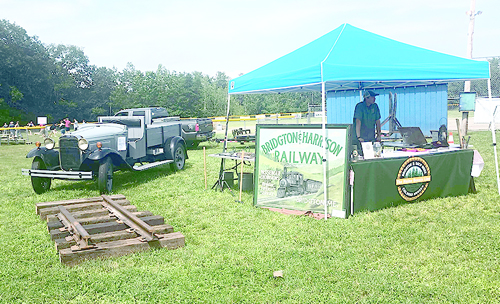One on One with…Rail man Adam Cook

By Wayne E. Rivet
Staff Writer
As Dalton Hulsey and Adam Cook made a three-hour drive to visit the Nevada Northern Railroad, their conversation naturally revolved around a common passion — the rails.
They talked about Bill Shelley’s attempt to revive the railroad in Bridgton between 2009 and 2014.
“I still remember my personal excitement for and later disappointment that it didn’t happen,” Cook said.
Ultimately, the rail enthusiasts posed a “what if?” Using their connections and education in the rail industry, could they bring a piece of history back to Bridgton in the form of a railroad museum?
Three years ago, Hulsey and Cook, along with four other rail enthusiasts took the plunge and started work on the Bridgton & Saco River Railroad Museum.
Born and raised in South Texas, Hulsey serves as board president and shop foreman. He grew up watching trains go by creating a passion for both railroading and history. According to the B&SR website, Hulsey worked with his father as a mechanic before moving to Bridgton. He learned repairs of a plethora of machines, big and small. Dalton got his first taste of railroading when he was hired on at Conway Scenic Railroad, where he worked as a railroad car mechanic, welder, carpenter, machinist, and general mechanic on both industrial machinery and locomotives. Shortly thereafter, he volunteered at the Wiscasset, Waterville, and Farmington Railway and Maine Narrow Gauge, where he worked on track projects.

A Bridgton native, Adam Cook serves as board vice president and secretary. He is the track foreman. Cook gained first-hand railroading experience after being hired onto the Conway Scenic Railroad track crew. Thoroughly loving the job, he pursued an education in track maintenance and track standards. He frequently volunteers at track work events at the Wiscasset Waterville & Farmington Railway and Maine Narrow Gauge Museum. Cook holds Federal Railroad Administration (FRA) backed certificates in track construction and standards, having received his higher education in track construction and maintenance through the University of Nebraska.
“All of the executive board and the majority of the board of directors are former Conway Scenic Railroad employees of various backgrounds from trackmen, to mechanics, to conductors and engineers,” Cook said. “Combined, the six principal members of the B&SR RR Museum have collectively more than 30-years of experience in the railroad industry.”
Last week, Maine Governor Janet Mills signed a bill authorizing the Commissioner of the Maine Department of Transportation to construct a multi-use “Trail Until Rail” from Standish to Fryeburg. Thirty-one miles of the Mountain Division Rail will be converted into an interim 10-foot wide paved bicycle and pedestrian trail.
That announcement, Cook felt, was a good springboard to bring awareness to area residents regarding the Bridgton & Saco River Railroad Museum project, as well as update the group’s progress.

BN: How did you get interested in railroads?
Adam Cook: I’ve always had an interest in them. Being a local and being told stories of the Bridgton & Saco River and Bridgton & Harrison as a kid really just boosted that interest along, plus going over to North Conway and Portland to visit the Conway Scenic Railroad and Maine Narrow Gauge respectively helped keep the interest alive.
BN: What was the initial vision/goal?
Adam Cook: Upon doing some rough surveying of what sections of the original right of way was left and some of the potential problems of some perspective locations, we settled on the goal of establishing a museum complex with a similar layout to the original Bridgton railyard but in a new location that had better access to a larger portion of intact right of way compared to the original railyard site on Depot Street. The idea being that this complex could stand on its own as a living history museum or could serve as a functional railyard once again if parts of the original main line could be restored.
BN: How did it evolve/and what are you hoping will be the end result?
Adam Cook: The plan evolved overtime as we started to clear hurdles. Once we found a suitable plot of land that allowed for the construction of what we had planned on Home Run Road we purchased itfrom the Rolfe Corporation. That’s when we realized we were in a perfect position to bypass the town transfer station, which was the largest hurdle for any operation and rebuilding that started from Depot Street, as the transfer station is built on the old right of way. Now, however, we could simply bypass that issue and could, theoretically, reconnect the two halves of the old line that are the easiest to restore, 1.5 miles back into downtown Bridgton and about six miles toward Sebago. Now in both cases, a new bridge crossing Sandy Creek would need to be constructed to connect our railyard site to the old right of way, along with getting all of the landowner permissions and easements. The theoretical restoration of the main line therefore is a Phase II or Phase III goal of ours, definitely following getting the museum complex up and running — even that will be determined by what easements we can get from the property owners.
BN: Give an overview of what has been accomplished thus far?
Adam Cook: For a brief overview, we incorporated in October of 2020. August of 2021 saw the IRS approve our 501c (3) status officially making us a non-profit organization. In October of 2021, we purchased our 5.1-acre parcel of land from the Rolfe Corporation. 2022 would prove a very productive year for us as we acquired our 10-ton Plymouth DLH-8 diesel locomotive, which we are currently in the process of restoring to operating condition. We additionally received a $10,000 grant from the Stephen and Tabitha King Foundation for brand new power track tools to aid in track construction and maintenance. Toward the end of 2022, we approached Sebago Technics to start the process of creating a site plan for our new site. Since the beginning of this year, we have managed to acquire an original B&SR freight car frame, which we are also in the process of restoring. This past June, we acquired a 1929 Ford AA truck similar to those used by the B&H as delivery trucks. Additionally, we got our first delivery of donated rail from the Belfast & Moosehead Lake Railroad of Unity (Maine). Sebago Technics completed our site survey work and recently sent us the first drafts of a site plan for our museum complex.

BN: What have been the biggest challenges/obstacles?
Adam Cook: The biggest challenge for us has been, and continues to be, funding for development and construction. This is especially true considering we started in the pandemic so our budget has always been fairly tight, especially as we are largely self-funded by our board members with much appreciated help from some generous donors and the occasional grant. That being said, we do try to deliver as much forward progress as we can every year. Even if the progress is slow, it’s still progress!
The second larger obstacle moving forward will be acquiring the easements to reactivate the right-of-way. We definitely respect property owners’ wishes and will be taking into consideration any thoughts and concerns anyone has in regards to any potential return of the railroad, especially property owners. We also respect that the local ATV and snowmobile clubs currently enjoy a large portion of the section of line that is the most feasible for us to rebuild. It is due to this we have not approached any landowners along the original right-of-way yet about easements. We wish to first get our museum up and running, which will take several years to do. We also wish to present a plan, which would allow all four parties involved — that being the railroad, property owners, the ATV clubs, and snowmobile clubs — to co-exist and be happy with the arrangement.
BN: What has public response been like when you have held fundraisers and when you have spoken to different groups?
Adam Cook: Public response to our efforts has been overwhelmingly positive, especially in regards to building the museum complex and our education initiatives. We are aided in this effort as many of the other two-footer organizations in the state have rallied behind us and have offered technical expertise and other help toward our efforts. Even standard gauge railroads have been helping us by donating track materials and offering support in terms of their machine shops for our projects that need them. It’s also been an amazing experience being able to listen to stories from locals about the railroad while simultaneously educating people new to the area about the history. During the railroad’s time in town, especially in the railroad’s golden age between 1900 to 1920, Bridgton was a different place. It was not only a popular tourist destination, but a very prosperous mill town.
One of our most common questions, along with concerns, are about what our goals are to which I repeat here. Our goal is first and foremost to build a museum complex where the locomotives and cars of the B&SR and B&H can be viewed and more importantly, maintained and preserved for future generations. The rebuilding of the railroad itself and activation of the line for tourist excursions beyond our own property will be entirely dependent on property owners giving us the permissions to do so. In these early stages, we have had some property owners approach us with some very valid concerns about what the railroad returning would do and we have listened to them and taken their concerns very seriously. In some cases, we assured them that the section of the old railroad they own is not one we even considered viable for restoration. We would encourage that for any readers of the paper that do own a portion of the old right-of-way and either have interest or concerns about the railroad returning to reach out to us. This is true even if they do not wish for the railroad to run across their property, as such a response will allow us to create a better picture of what our options and prospects for future expansion are.
Personally, one of my favorite things has been researching the locomotives and particularly locomotives #5 through #8 because of their unique wheel arrangement. In Whyte notation, these engines were 2-4-4T’s, that being steam locomotives with one leading axle, two drive axles, and then two unpowered trailing axles without a separate tender making them tank engines, hence the T designation. This is actually a very rare wheel arrangement, with only six railroads in the U.S. making use of the type in any notable quantity, with Maine two-foot railroads accounting for three of those six. Of the Maine three, the B&SR was the largest user of the type with a full half of the locomotive roster being 2-4-4T’s including of course #5 which was the prototype of the Maine “Boston’s.” A fun fact is that the B&SR helped pioneer an entire class of locomotives for all of the Maine two-footers.
Speaking of the “Boston'” nickname for this locomotive type was also a fun discovery. Most publications regarding the two footers call 2-4-4T and 0-4-4T locomotives “Forneys,” which is not technically wrong, both use Forney style frames and layouts. It is however only 0-4-4T’s that are traditional “Forney'' wheel arrangements with the 2-4-4T’s in other national publications having various other names. A 1906 Baldwin manual for example calls them “Forney-Moguls” while some others refer to them as “Boston’s” after the Boston, Revere Beach, and Lynn Railway of Massachusetts. The BRB&L Ry was both the first user of the wheel arrangement here in the U.S and also had the largest roster of the type, totaling over 24 locomotives.
BN: You mention you have acquired various “artifacts.” What are they?
Adam Cook: We’ve managed to collect quite the collection of artifacts from the old railroads. Many of these items include tickets, ledgers, waybills and various other paperwork. There are three items currently in our collection that stand out for having an interesting story, one of which definitely shows the appeal of the town’s little two-footer far outside of the state of Maine. So, I’ll start with the story of how we acquired the railroad’s 1898 ledger.
Starting at the end, we acquired the ledger in 2022 from a railroad paperwork collector in Kentucky, who had it for sale after acquiring a collection of railroad paperwork from an estate sale in another southern state. The story behind the ledger ending up down there starts with the dying months of the B&H in the early 1940s when railfans, also known as “rail enthusiasts” then, started offering the B&H money for pretty much anything that wasn’t nailed down or critical to the struggling railroads operation. Sadly, it is unknown if the ledger was acquired during this period, during some of the last rail enthusiast excursions to Bridgton or if it was acquired during the railroad liquidation between September and October of ’41. Regardless, it made its way down south and changed hands a few times before ultimately ending up in the hands of the woman we bought it from — bringing the ledger back home for the first time in over 80 years.
The second artifact is that we managed to acquire was one of two surviving advertising signs from the original Bridgton station in the 1930s-1940s. This particular sign went down to the Edaville Railroad in South Carver, Mass. and was displayed in the station down there. A fitting palace as it was now “home” with much of the surviving B&SR engines and cars. We ended up acquiring it from Joan Barney, the widow of Peter Barney earlier this year. Peter Barney helped run Edaville in its later days and published a series of books on the two-footers, including the B&SR and B&H.
Now our most exciting artifact in our possession right now is unfortunately the one we can talk the least about as we are still researching its history. We managed to acquire an original 30-foot B&SR boxcar frame, which we are currently in the process of restoring. This restoration will only be a partial restoration to a flatcar initially as we have a more pressing need for flat cars at the moment, though we have every intention of restoring it to a boxcar further down the road.
BN: You mention that you are preparing a site plan, can you share a few details and what might be the next steps?
Adam Cook: Our initial site plan includes provisions for four principle buildings which break down as follows:
• A car shop that is 60 feet wide and 120 feet long. This will be our primary restoration and storage building with a capacity to store and work on several cars or locomotives at once in two bays. Though much larger than the original car shop we hope to keep a similar exterior appearance while having a new state of the art facility inside.
• An 80-foot wide by 60-foot long engine house. This will be for the storage and basic maintenance of up to four locomotives. The design is going to be nearly a copy of the four-stall roundhouse that was a critical part of the original Bridgton Railyard.
• A 30-foot wide by 60-foot long station that will act as our welcome center and hopefully in the future will function as a proper station for tourist excursions. The design and footprint are heavily based on the original Bridgton station.
• A 30-foot wide by 60-foot long freight house. This will act as our museum proper with artifacts of the original railroad on display along with various other infographics. Its design will be based on the original Bridgton freight house though reduced in size.
• Lastly, the site plan includes provisions for a 50-foot diameter turntable in front of the engine house.
Our site plan hopes to re-create as much of the original feel and character of the original B&SR yard in Bridgton as possible while also accounting for the different terrain on our property. As for next steps, our next two big hurdles are finalizing the plan so it can go before the Planning Board as well as undergo state review before we get permission to start construction. Once approval is given, the first building we hope to construct is the car shop as that will allow us to move our diesel locomotive and boxcar frame onto property to more efficiently continue restoration work on those projects. The rest of the complex will be built over a several year period as funds and needs require.
BN: Finally, what have you found to be most rewarding about this venture?
Adam Cook: The most rewarding aspect has been the feeling of community for undertaking this project. I am constantly humbled by the support we receive, especially locally and from away. Some of the people who have donated either items or money to us come from California, Texas, South Carolina, Germany, the U.K, and Canada — just to name some examples of both far-away states and foreign countries. This enthusiasm for what we’re trying to do is particularly true when it comes to local events. I love hearing the stories from locals when we are at various regional events or the seminars we host at various historical societies.
For more information about the Bridgton & Saco River Railroad Museum, check the group’s website.

